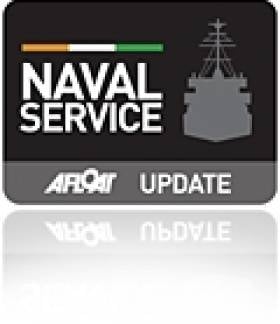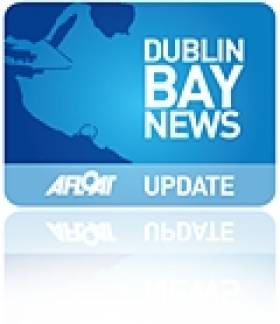Displaying items by tag: Mariners Church Dun Laoghaire
Baroque Concert in Old Mariners Church
#BaroqueConcert – Dublin-based early music ensemble Respicio are to perform in the National Maritime Museum of Ireland (NMMI), Dun Laoghaire this Friday 31 May.
Come along to the hear music by Teleman, Bach & Graupner, starting at 8pm (tickets cost €10) in the unique surroundings of the maritime museum. The restored former Mariners Church, was awarded earlier this year the Best Museum / Restored Site at the 2012 Industrial Heritage Association of Ireland Awards.
The museum is (mostly) wheelchair accessible and during normal opening hours, 11am-5pm every day, there is a Museum Café serving hot snacks throughout. There is also a WiFi hotspot. For further information about the museum run by the Maritime Institute of Ireland visit: www.mariner.ie
Mariners’ Church featured in New Life for Churches in Ireland
#MARINERS CHURCH – NEW LIFE for Churches in Ireland – Good Practice in Conversion and Reuse is the title of a new multi-authored publication. Among the diverse range of 17 case studies is the former Mariners' Church, Dun Laoghaire, which as the National Maritime Museum of Ireland was officially reopened in June by President Michael D. Higgins.
At the reopening President Higgins said "This magnificent old Mariners' Church is one of the few large mariner churches in the world. It is a beautiful building...it is great to raise awareness of our maritime heritage".
Writing about the former Church of Ireland place of worship, Peter Pearson details the history of the building erected in 1836 to the designs of Joseph Welland for the benefit of the many sailors who were based on Royal Navy vessels in the then new Kingstown Harbour.
Accompanying the case study are photographs including those taken by Jehan Ashmore on the day of the reopening to illustrate the building which underwent substantial conservation and renovation work (between 2005-2011) by James Slattery Architects.
Asides the Mariners' Church there are further case studies from throughout the island of Ireland, amongst them Elmwood Hall in Belfast, Carlingford Heritage Centre, Triskel Christ Church, Cork and St. Werburgh's Church, where last month the book had its Dublin launch.
Also featured are more modest but nevertheless important schemes, followed by a section featuring projects where work is underway but not complete. Schemes include the conversion of churches for domestic as well as cultural, commercial and community use. Each of these case studies are underpinned by an analysis of our ecclesiastical heritage, a flow chart to stimulate discussion on underused churches and an explanation of conservation principles and statutory responsibilities.
The 144-page publication is produced by the Ulster Historic Churches Trust and edited by Paul Harron. Among the other contributors are Edward McParland, Grainne Shaffrey, Patrick Shaffrey, Michael O'Boyle and Alistair Rowan. The book has a wealth of full colour photographs, drawings and illustrative material throughout.
Retail prices are €15 / £12 (softback) and €20 / £18 (hardback) and they can be purchased from the following stockists:
DUN LAOGHAIRE: Maritime Museum Gift Shop, National Maritime Museum of Ireland, Mariners'Church, Haigh Terrace (note: Open 11am-5pm Everyday)
DUBLIN: RIAI Bookshop / Irish Georgian Society (both on Merrion Square), Dublin Civic Trust, Castle St. (beside Dublin Castle) and St. Michan's Church office
BELFAST: Good Book Shop, Donegall St. (beside St Anne's Cathedral)
or available through Amazon.
ISBN: 978-0-9573791-1-4
New Lease of Life for Reopened Maritime Museum
#MARITIME MUSEUM REOPENING – It is good to report positive news, particularly the much awaited reopening of the Maritime Institute of Ireland's maritime museum in Dun Laoghaire, which is to take place today, writes Jehan Ashmore.
Since 2006, the museum secured vital Government grants to undertake repair, renovation and improvement works of the former Church of Ireland church built in 1837 which could accommodate up to 1,400 people. Due to dwindling parish numbers the church closed on Easter Sunday 1972 and two years later the museum moved in.
Over the next three decades visitors enjoyed the unique and apt setting of the former Mariners Church. However as the years rolled the structure of the building was in need of urgent attention which led to the closure in 2004.
The extensive work has included the replacement of the roof, treatment of dry rot, repointing and cleaning of the stonework, replaced plasterwork, repair of the stained glass windows, installation of new lighting and heating systems and wheelchair accessibility provided.
Initially the museum will only use the ground floor, having said that a new layout is presented with several 'stories' centred around these exhibits, to read more about the exhibits click HERE.
In addition children will be entertained by a Knot Station and there is to be a souvenir shop and coffee dock. Opening hours are 11am to 5pm Tuesday to Sunday, including Bank Holidays, for further information visit: www.mariner.ie
The Maritime Institute of Ireland celebrated its 70th anniversary last year, and was established primarily to highlight the importance of an Irish mercantile fleet, the role of ports and shipping, fishing and to recognise and foster our maritime heritage.
Members can join the Institute with the benefits of accessing the museum (covering admission) runs a lecture programme, issue newsletters, host and support commemorations and conducts research. As a voluntary organisation they also welcome new recruits.
The instiute's patron is President Michael D. Higgins who is to officially reopen the museum in early June.
Homage Paid to Irish Founder of Argentinian Navy
#ADMIRAL BROWN- As Wexford is to host The John Barry Maritime Festival this summer, the father of the US Navy and commodore is held in the same league of Admiral William Brown, who founded the Argentinian Navy, who was remembered in a ceremony over the weekend in Buenos Aires, writes Jehan Ashmore.
The commemoration was to mark the 155th anniversary of William Brown's passing which took place at the Recoleta Cemetery, which was headed by Vice Admiral Carlos Alberto Paz, Chief of Staff of the Argentine Navy.
Among those attending were the Irish Ambassador, Mr. James McIntyre, the Chairman of the National Brownian Institute, Prof. Emilia Menotti, the President of the Naval Club, Vice Admiral Eduardo R. Llambi (Ret.) and City Council Officials.
The Navy General Directorate for Education marching band was also present, as well as Officer Cadets from the Admiral Brown Naval Lyceum (Reserve Officers' Academy). The Irish flag was carried alongside the host country by officers of the HQ Security Marine Bn.
For more about the event which included Santiago L. Aversa who represented the Irish branch of the Maritime Institute of Ireland (click HERE) and where its maritime museum in Dun Laoghaire is due to reopen early next month as previously reported on Afloat.ie
In 2006 the Naval Service 'flagship' L.É. Eithne (whose adopted homeport is Dun Laoghaire) under the command of Commodore Mark Mellett, made a historic first for the Naval Service when visiting Argentina and other South American ports.
In the same year two identical statues of the admiral were unveiled, one in Dublin's Docklands at Admiral Brown Way and Westport, Co. Mayo where the admiral hailed from.
Admiral Brown won victories against the Spanish and Brazilian fleets and as such he is regarded as a national hero, where in excess of 1,000 streets, 400 statues and venues such as stadiums (including football teams) schools, several towns, and a major city bears his name.
- naval service
- Argentinian Navy
- L.E. Eithne
- Commodore John Barry
- Admiral William Brown
- Commodore Mark Mellett
- M.I.I.
- Maritime Institute of Ireland
- Mariners Church Dun Laoghaire
- Maritime Museum Dun Laoghaire
- Dublin Docklands
- The John Barry Maritime Festival
- Admiral Brown Way
- Irish Ambassador McIntyre
- Westport Co Mayo
- Wexford Town
Screening Shown of Unique Lives Lost at Sea Ceremony
#MARINERS WITH MEMORIES – At the weekend representatives of the maritime community, relatives and visitors alike attended a screening of the 'Mariners with Memories' ceremony, which was shown in the Maritime Museum, Dun Laoghaire.
The ceremony which took place in Bray Harbour last July, is unique in that it recognises to all those lost to sea throughout the world and especially to those whose grave is the sea.
Shot by Colm Fynes, the film documented the day's proceedings with tributes made at the Co. Wicklow harbour and the flotilla that followed with floral tributes carried out close to the shore.
Captain Tony O'Grady who organised the Mariners with Memories ceremony, thanked all those to the museum and the support of the Maritime Institute of Ireland, whose newly renovated museum was a particularly apt venue, being the former Mariners Church.
Some of the relatives who attended the memorial event in Bray were also at the Dun Laoghaire screening and where they gave moving tributes to loved ones.
Commenting on the poignancy of the screening, Captain O'Grady referred to the on-going tragic events in Glandore Harbour and off the Italian island of Giglio.
He added that those involved in the various services off the West Cork fishing harbour would of liked to have attended but given the circumstances, all the resources were required at the scene.
It is hoped that following the inaugural ceremony, that Mariners with Memories will become an annually held event and the close relationship with the museum continues.
The museum which was especially opened for the screening will remain closed throughout the winter months though is open on an invitation only basis. Officially the museum is due to re-open this Easter, to keep posted of further developments visit www.mariner.ie
Screening to Mark ‘Mariners with Memories’
#MARITIME MUSEUM - A video recording of the 'Mariners with Memories" wreath-laying ceremony held at sea off Bray last year, is to take place tomorrow afternoon (at 14.30) in the maritime museum in Dun Laoghaire.
The ceremony which was held on 30 July involved a flotilla off Bray Harbour where floral tributes were made to commemorate all those lost at sea especially those whose last resting place is the sea which claimed their lives.
In addition the video presentation will also mark the 70th anniversary of the formation of Irish Shipping Ltd in 1941 and the founding of the Maritime Institute of Ireland (M.I.I.) which was also established in that year.
Copies of the D.V.D. will be available on request R.S.V.P. to this email: [email protected]
The institute aims are to foster an appreciation of the nation's maritime heritage and the museum which is located in the former Mariners Church. The museum has been closed for several years due to essential renovation, though is open on an invitation only basis during this winter. It is due to be officially re-opened in Easter of this year.
Activities of the M.I.I. (which is open to members) include running a winter/spring lecture programme, newsletters, a library, research and the hosting and supporting of commemorations.
For more information including how you can support them as a volunteer click HERE
Christmas Concert for Maritime Museum
#EVENTS-A light-hearted performance of Christmas Music for the Festive Season is to be held at Christ Church Park Road, Dún Laoghaire in aid of the Maritime Institute of Ireland's museum restoration fund.
All are welcome to the evening's performance by the 'Firhouse Singers' which starts at 7.30 pm on Friday 16th December. Refreshments will be available and an admission of €10.00 at the door.
For additional information about the museum visit www.mariner.ie
Lecture: Reminiscences’ of Maritime Institute of Ireland and Maritime Museum
Kevin will be recounting his involvement with the acquisition of many of the museum's artefacts in addition to the part he has played in representing the M.I.I. on such issues as sail-training, and the National Monuments Legislation with relation to the Armada finds in Ireland. In addition, Kevin is an experienced yachtsman and he will be touching on that subject too during the evening.
The museum which is situated in the former Mariners Church, Haigh Terrace is due be re-opened with a 'preview' from 16 October 2011 to mark the M.I.I.'s 70th anniversary. The museum is due to be officially opened in Easter 2012. For more about the M.I.I., its museum and activities www.mariner.ie
Dun Laoghaire Harbour's Sunday 'Family-Funday'
Opening times are 11am to 5pm and the entry fee is €3 for adults and children go free. The Funday is to help raise funds to support the local national maritime museum of Ireland in Dun Laoghaire. The Maritime Institute of Ireland is a registered charity, which run the museum through volunteers. In addition they host lectures, represent maritime interests and operate a museum and library.
The museum is housed in the former Mariners Church and is currently closed due to renovation and improvement works. There will be a 'soft launch' or 'preview' of the museum from October to mark the M.I.I.'s 70th anniversary.
Next year the museum is due to be officially re-opened during the Easter. The M.I.I. welcomes new members, volunteers and donations. For further information visit www.mariner.ie
- Pirates
- Carlisle Pier
- Dublin Bay News
- Maritime Institute of Ireland
- Dun Laoghaire Harbour
- M.I.I.
- Mariners Church Dun Laoghaire
- Dun Laoghaire Harbour News
- Irish maritime museums
- Family Funday
- DART Dun Laoghaire
- DART railway
- Pirats and Princesses competition
- Irish maritime interests
- Irish maritime lectures
- Irish maritime library
- National Maritime Museum of Ireland
- NMMI
‘Family Fun Day’ in Dun Laoghaire
Funds raised will go to the maritime museum which is housed in the former Mariners Church, which is run by the Maritime Institute of Ireland (M.I.I.). The museum is currently closed due to continued renovation and improvement works.
There will be a 'soft launch' or 'preview' of the maritime museum from October to mark the M.I.I.'s 70th anniversary. Next year the museum is due to be officially re-opened during the Easter. The M.I.I. welcomes new members, volunteers and donations to assist in the museum. For information visit www.mariner.ie







































































